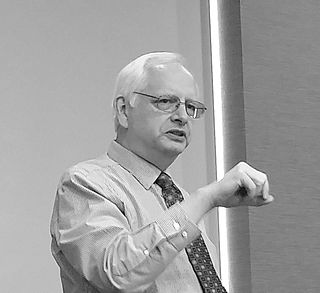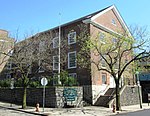Methodism, also called the Methodist movement, is a group of historically related denominations of Protestant Christianity whose origins, doctrine and practice derive from the life and teachings of John Wesley. George Whitefield and John's brother Charles Wesley were also significant early leaders in the movement. They were named Methodists for "the methodical way in which they carried out their Christian faith". Methodism originated as a revival movement within Anglicanism originating out of the Church of England in the 18th century and became a separate denomination after Wesley's death. The movement spread throughout the British Empire, the United States and beyond because of vigorous missionary work, and today has about 80 million adherents worldwide.

John Wesley was an English cleric, theologian, and evangelist who was a leader of a revival movement within the Church of England known as Methodism. The societies he founded became the dominant form of the independent Methodist movement that continues to this day.

Charles Wesley was an English leader of the Methodist movement. Wesley was a prolific hymnwriter who wrote over 6,500 hymns during his lifetime. His works include "And Can It Be", "Christ the Lord Is Risen Today", "Love Divine, All Loves Excelling", the carol "Hark! The Herald Angels Sing", and "Lo! He Comes With Clouds Descending".
The Methodist Episcopal Church, South was the American Methodist denomination resulting from the 19th-century split over the issue of slavery in the Methodist Episcopal Church (MEC). Disagreement on this issue had been increasing in strength for decades between churches of the Northern and Southern United States; in 1845 it resulted in a schism at the General Conference of the MEC held in Louisville, Kentucky.
Albert Cook Outler was a 20th-century American Methodist historian, theologian, and pastor. He was a professor at Duke University, Yale University, and Southern Methodist University. He was a key figure in the 20th-century ecumenical movement.

Candler School of Theology is one of seven graduate schools at Emory University, located in metropolitan Atlanta, Georgia. A university-based school of theology, Candler educates ministers, scholars of religion and other leaders. It is also one of 13 seminaries affiliated with the United Methodist Church.
The Methodist Church of Great Britain is a Protestant Christian denomination in Britain, and the mother church to Methodists worldwide. It participates in the World Methodist Council, and the World Council of Churches among other ecumenical associations.
Arthur James Moore was an American bishop of the Methodist Episcopal Church, South (MECS), the Methodist Church, and the United Methodist Church, elected in 1930.

John Christian Keener was an American bishop of the Methodist Episcopal Church, South, an author and an editor, and the superintendent of C.S.A. Chaplains west of the Mississippi River during the American Civil War. He wrote several books on theology and edited the New Orleans Christian Advocate, a weekly Methodist newspaper sponsored by Methodist conferences in Louisiana and various nearby states in the late-19th and early-20th century. A collection of Keener's papers, available at the Stuart A. Rose Manuscript, Archives, and Rare Book Library at Emory University, include correspondence and military orders related to the return of property to the Methodist Church, South, after the war.
Naphtali Luccock (1853–1916) was an American bishop of the Methodist Episcopal Church, elected in 1912.
Earl Gladstone Hunt Jr. (1918–2005) was an American who distinguished himself as a Methodist pastor and evangelist, as the president of Emory and Henry College, as an author and theologian, as a bishop of The Methodist Church and the United Methodist Church, and as a leader in World Methodism.
Nolan Bailey Harmon was a bishop of The Methodist Church and the United Methodist Church, elected in 1956.
Roy Hunter Short was an American bishop of The Methodist Church and the United Methodist Church, elected in 1948.

Barratt's Chapel is a chapel located to the north of Frederica in Kent County, Delaware. It was built in 1780 on land donated by Philip Barratt, owner of Barratt Hall, and a prominent local landowner and political figure. Barratt, who had recently become a Methodist, wanted to build a center for the growing Methodist movement in Delaware.

Francis G. Waters, D.D., LL.D., was a Methodist minister from Baltimore, Maryland, U.S., and a founding member of the Methodist Protestant Church. He was elected as the first president of the church on November 2, 1830, and presided over the general convention, in which the church's constitution was adopted. From 1849 to 1853 Waters served as the second principal of Baltimore City College. He was selected as president of Madison College in Uniontown, Pennsylvania, in summer 1853 but left the institution later that fall because of family illness. He also served twice as the Principal of Washington College in Chestertown, Maryland.

Wesleyan theology, otherwise known as Wesleyan–Arminian theology, or Methodist theology, is a theological tradition in Protestant Christianity based upon the ministry of the 18th-century evangelical reformer brothers John Wesley and Charles Wesley. More broadly it refers to the theological system inferred from the various sermons, theological treatises, letters, journals, diaries, hymns, and other spiritual writings of the Wesleys and their contemporary coadjutors such as John William Fletcher.
The Wesleyan Methodist Church was the majority Methodist movement in England following its split from the Church of England after the death of John Wesley and the appearance of parallel Methodist movements.

Epworth by the Sea is an 83-acre Christian conference and retreat center in Georgia, United States. It is used for Methodist-based events. It is located on the banks of the Frederica River, north of Gascoigne Bluff on Saint Simons Island, Georgia. The center was named "Epworth by the Sea" in honor of Epworth, the boyhood home of Charles and John Wesley, founders of Methodism. It is owned and operated by the South Georgia Conference of the United Methodist Church. Epworth is located on part of Hamilton Plantation which was purchased on October 29, 1949. It opened to the public in 1950, under the leadership of Bishop Arthur James Moore. Moore, from Georgia, was an elected bishop in the Methodist Episcopal Church, and also a leader of the Atlanta Area of the Methodist Church. At the start, the center featured only a few rural camp facilities and old plantation buildings. Epworth's stated mission is "to provide a Christian place for worship, study and fellowship."

The history of Methodism in the United States dates back to the mid-18th century with the ministries of early Methodist preachers such as Laurence Coughlan and Robert Strawbridge. Following the American Revolution most of the Anglican clergy who had been in America came back to England. John Wesley, the founder of Methodism, sent Thomas Coke to America where he and Francis Asbury founded the Methodist Episcopal Church, which was to later establish itself as the largest denomination in America during the 19th century.

Randy L. Maddox is an American theologian and ordained minister in the United Methodist Church. He served until 2020 as the William Kellon Quick Professor of Wesleyan and Methodist Studies at Duke University. Maddox also serves as the General Editor of the Wesley Works Project, a major scholarly project responsible for producing the first comprehensive and critical edition of the works of John Wesley. He is considered one of the leading authorities on both the theology of John Wesley (1703-1791) and the theological developments of later Methodism.






























